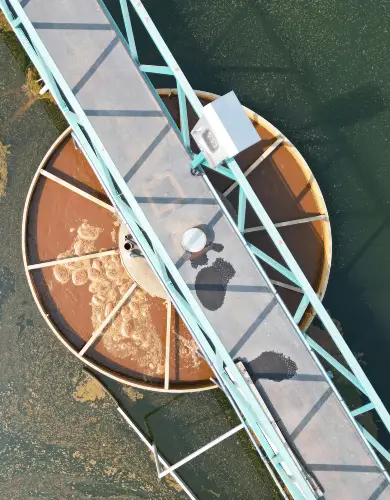A comprehensive guide to energy storage
Green energy storage is essential for the UK to fully replace fossil fuel power plants.
Wind and solar have become a complication for grid operators who need to re-balance their intermittent power through electricity imports or by using the idle capacity on any coal or gas plants.
Without energy storage’s grid stability services, countries seeking to succeed in the digital world will struggle.
In this comprehensive guide, we explain why we urgently need green energy storage and cover how the different technologies (for both electrical and thermal storage) fit into creating the robust and low-carbon green grid everyone seeks.
Contents
- Renewables cannot adapt to varying electricity demand
- A more robust national grid
- Low carbon energy storage
- Responsive, intense or long-term energy storage?
- Micro-grid energy storage
- Thermal Energy Storage
- Conclusion
- External Resources
Why is energy storage so important?
Renewables cannot meet electricity demand
Unlike fossil fuel power plants with plenty of spare fuel, intermittent renewables like wind and solar cannot adjust their power output on command as their output depends on weather conditions.
And as a growing proportion of the grid’s electricity is coming from renewables, the only other way to make up for the shortfall without increasing carbon emissions is through energy storage.
Understanding this imbalance requires understanding how electricity demand changes throughout the day and year. Take, for instance, the UK’s household electricity demand curves below.
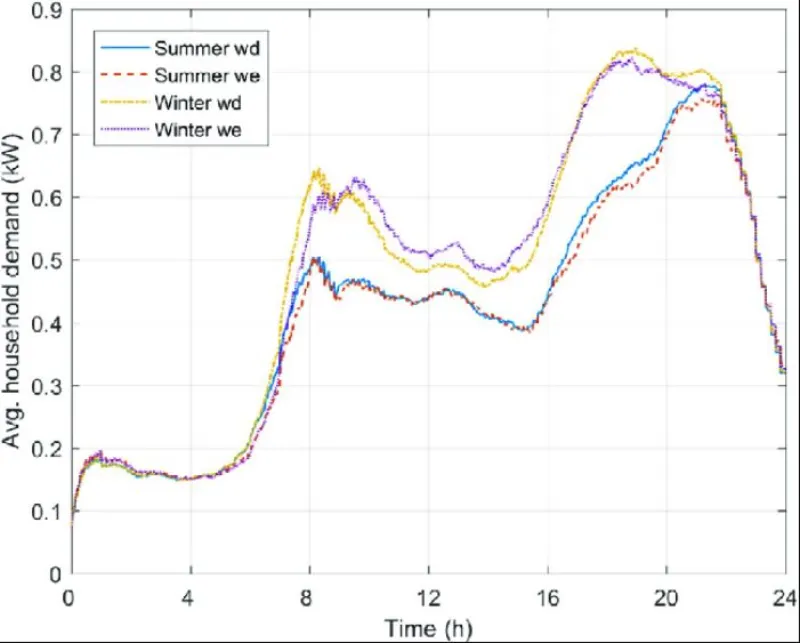
It clearly shows the huge gap in peak hour demand compared to off-peak hours throughout the year, which is also modulated by the seasons. Three times more electricity is needed at 7 pm on a typical winter evening compared to 4 am on a typical summer night.
This rapidly becomes more complex as the demand curves for businesses and industries are included (which have different peak times and seasonal requirements). Also, these curves are constantly changing over time as consumption habits are changing as things like smart phones, heat pumps and EV charging are rolled out.
Grid operators cannot call wind and solar generators and ask them to ramp up power output to meet these demand curves and will never be able to do so. Instead, they would need to call energy storage facilities to discharge the stored power in order to meet any supply shortfall.
So far in its electrical history, the UK has relied on fossil fuel plants for grid re-balancing. But with the aggressive decommissioning of coal and gas power stations during the last decade, the UK has recently had to rely on electricity imports, Drax’s controversial biomass power station, and the remaining gas plants to keep things going.
It should be noted that the UK is legally bound to reducing its emissions year-on-year according to its ETS, so this aggessive decarbonisation of the energy grid is also necessary!.
A more robust national grid
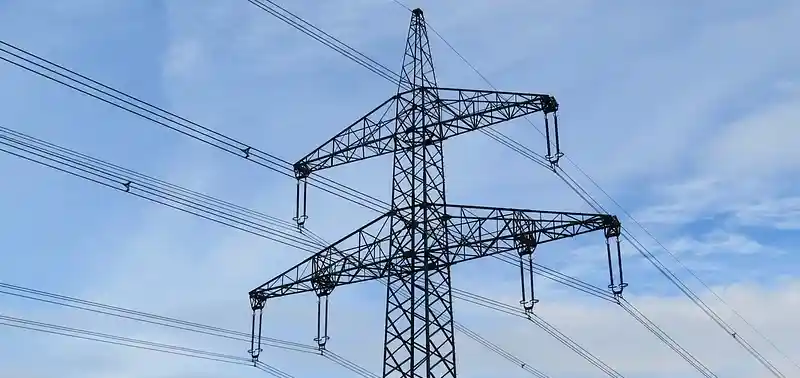
Before the recent renewables boom (circa 2010s), fossil fuel power stations provided both the baseload (together with nuclear) and grid stabilising capabilities.
Power stations were able to fine-tune the rate at which the turbines turned in order to keep a well-balanced grid at all times, providing essential grid stability services such as: frequency regulation, voltage support, spinning reserve, load following and ramp rate control.
However, there is only so much fine-tuning a large power station can achieve without the support of additional infrastructure, like energy storage. So even when the UK grid is considered one of the most robust in the world, there are still improvements that could be made.
For example, in 2019, the average household had power interruptions for 35 minutes per customer per year, including one major frequency instability event that resulted in a widespread power outage to over one million people in the UK for 45 minutes.
Having a decentralised network of grid ‘batteries’ that can reach much higher response rates than power stations (e.g. flywheels and battery farms) would be able to improve this resilience and give the UK more tools to tackle new threats such as grid cyber attacks, in conjunction with other initiatives like the Demand Flexibility Services.
What kind of storage is needed?
Not all energy storage is built equal. There are both low-carbon and fossil alternatives, and all of them vary in responsiveness, scalability, power capacity, discharge time, etc. Let’s take a look.
Low carbon energy storage
Since reducing carbon emissions is necessary to fight against climate change, non-polluting energy storage systems are needed.
Historically, fossil fuels like oil, gas and coal, as well as biomass and biofuels have been used as energy storage because they are imperishable and can be immediately burnt to be transformed into heat or electricity. Recharging = filling storage; Discharging = burning the fuel to drive the turbines.
They are also extremely convenient as these fuels can also take on the role of providing baseload energy, long-term strategic storage, and transportable fuel for transportation due to their high energy density.
However, the whole point is to replace these with low carbon options, of which there are many. Also, the UK and all signatories of UN treaties are legally bound to reduce their emissions according to the schedule set out by their respective ETS, so there aren’t ways around this.
Responsive, intense or long-term energy storage?
Grid imbalances between supply and demand happen at various timescales and intensities. For example, the fluctuating output of a gas power station requires live re-balancing using very responsive power injection, while an evening game at Wembley Stadium requires a couple of hours of consistent power at peak times.
Different technologies offer different response times, scalability, power capacity and discharge duration. The graph below provides a great way to visualise how different technologies have their own niche.
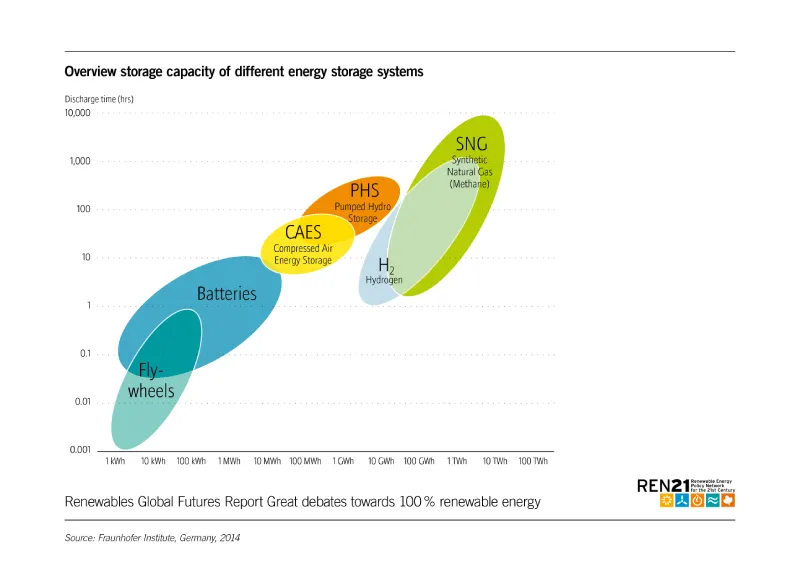
Mechanical storage, such as flywheels are capable of providing energy within fractions of a second of being given the order but can only inject power for a couple of minutes at a limited capacity. This makes it very useful for high-frequency fluctuations and emergency power.
Another responsive option is gravitational storage, which can start turning a turbine as soon as given the order to discharge. It’s still at the concept stage, and its price and scalability are still being questioned.
Li-Ion batteries can respond almost as fast (if not as fast) and provide larger amounts of power for longer, which means that they may be more effective for large disturbances to the grid balance. However, this technology is marred in environmental controversy due to its recycling woes and has a much shorter life cycle.
CAES (Compressed Air Energy Storage) and PSH (Pumped-Storage Hydro) facilities may take minutes before they can discharge power to the grid, but once they begin, the floodgates literally open. The CAES of the future and the PSH of now can provide many Megawatt and even Gigawatt amounts of power over multiple days, making it ideal for significant nationwide imbalances.
And then there is the underground hydrogen pipe dream, which has only been theorised. But if implemented, would be able to store strategic, national-scale amounts of power, providing many GW of power for weeks on end, despite any international embargos.
Micro-grid energy storage
The increasing role of distributed grids within national grids means that energy storage must also suit this niche, especially as many of these are small and off-grid, and cannot rely on the national grid.
The ubiquity and decreasing cost of Li-Ion batteries has proven to be the preferred solution here, but as developments in energy storage accelerate, we expect there to be micro-versions of all energy storage solutions.
CAES in small tanks, or Micro-PSH within an urban water system, are examples of small-scale, potentially low-cost alternatives for off-grid energy storage. Flywheels are already in use in many distributed grids, particularly for applications that require very stable power like Particle Accelerators and cloud data centers.
And more excitingly, innovations like EVs, smart meters for businesses and blockchains are opening exciting possibilities when it comes to micro-storage, where average Joe citizens and businesses may be able to compose a large portion of the national or global storage capacity by acting like a fragmented, fully decentralised mega battery.
Thermal Energy Storage
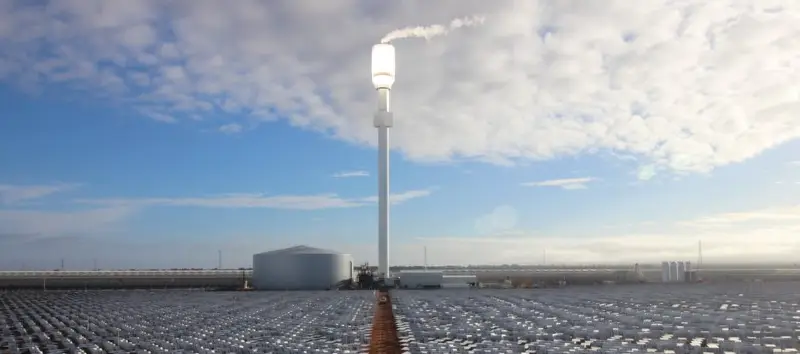
Another useful way of storing energy is by storing heat instead of electricity. In some cases like in the UK (half of the energy consumed in UK households is used for heating!), heat storage may even be more important than electricity, especially considering that most of this comes from carbon-intensive gas boilers.
And there are ways of storing heat directly from intermittent renewables, like the sand batteries that are being developed in Finland to store wind and solar energy within sand bunkers. When the heat is needed, water percolated through the bunker transfers the thermal energy into where it’s needed, be it indoor radiators, swimming pools, hot water tanks, etc.
Another alternative is thermal solar energy, which is being revived thanks to its ability to store energy (it was rapidly losing ground over cheap solar panels). In this tech, mirrors concentrate incoming sunlight into one spot, typically a solar tower that is connected to a molten salt heat reservoir.
And for decentralised grids, thermal water prisms are introducing an easy way in which to heat water from sunlight, which can then be stored in an insulated tank.
And let’s not forget that heat is another way to store electrical energy, as it can be used to drive a steam turbine system and voila, electricity is produced!
Conclusion
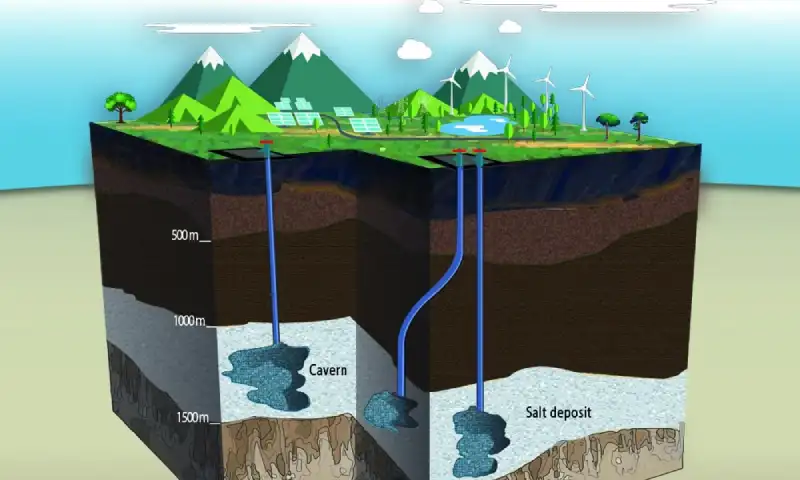
Growing the energy storage capacity is at the core of the energy transition. Without it, intermittent renewables will not be able to become the complete solution that fully replaces fossil fuels, and national grids will become less resilient.
Particularly considering that climate change is bringing unprecedented levels of extreme weather uncertainty, while the likelihood of cyber-attacks is increasing as we delve deeper into the digital age.
Also the 2022 energy crisis taught us that this needs to be a gradual, organised transition where large-scale energy storage gradually replaces fossil fuels and international imports- which is a realistic endeavour.
In any case, energy storage is a cornerstone of the 2050 AquaSwitch pipe dream, where entire continents have strategic TWh-scaled underground green hydrogen while regular citizens and businesses leverage fully decentralised, permissionless p2p electricity swapping schemes to become principal participants in the energy market.
External Resources:
- Electricity Demand – Journal of Energy Storage
- eilateilot.org – Storage Capacities
- UK Gov – GB Power System Disruption
- Sundrop Farms
- AS Schneider

